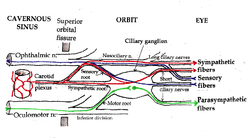Sympathetic root of ciliary ganglion
| Sympathetic root of ciliary ganglion | |
|---|---|

Pathways in the Ciliary Ganglion. Green = parasympathetic; Red = sympathetic; Blue = sensory
|
|
| Details | |
| From | Internal carotid plexus |
| Identifiers | |
| Latin | ramus sympathetica ganglii ciliaris |
| Dorlands /Elsevier |
r_02/12688108 |
| TA | A14.3.02.004 |
| FMA | 67548 |
|
Anatomical terms of neuroanatomy
[]
|
|
The sympathetic root of ciliary ganglion is one of three roots of the ciliary ganglion, a tissue mass behind the eye. It contains postganglionic sympathetic fibers whose cell bodies are located in the superior cervical ganglion. Their axons ascend with the internal carotid artery as a plexus of nerves, the carotid plexus. Sympathetic fibers innervating the eye separate from the carotid plexus within the cavernous sinus. They run forward through the superior orbital fissure and merge with the long ciliary nerves (branches of the nasociliary nerve) and the short ciliary nerves (from the ciliary ganglion). Sympathetic fibers in the short ciliary nerves pass through the ciliary ganglion without forming synapses.
Preganglionic sympathetic fibers originate from neurons in the intermediolateral column of the thoracic spinal cord, at the level of thoracic spinal nerve 1 (T1) and thoracic spinal nerve 2 (T2). They form synapses in the superior cervical ganglion. The ratio of incoming to outgoing fibers (the “convergence”) in this ganglion is approximately 100:1. Sympathetic motor neurons in the spinal cord are controlled by supranuclear pathways that descend through the brainstem and spinal cord. Interruption of the sympathetic chain at any level (from the brainstem to the ciliary ganglion) will produce pupillary constriction (miosis) and eyelid droop (ptosis) – the classic signs of Horner's syndrome.
Sympathetic fibers from the superior cervical ganglion innervate blood vessels (vasoconstriction), sweat glands, and 4 eye muscles: the dilator pupillae, the superior tarsal muscle, the inferior tarsal muscle and the orbitalis.
The dilator pupillae dilates the pupil; its action is antagonistic to the sphincter pupillae. Pupil size is therefore under the dual control of sympathetic and parasympathetic nerves.
Postsynaptic sympathetic signals that originate in the superior cervical ganglion are carried by the nasociliary nerve or directly extend from the internal carotid plexus and pass through the ciliary ganglion.
...
Wikipedia
